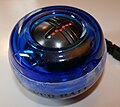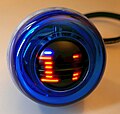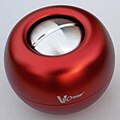Gyroscopic exercise device
The gyroscopic exercise device is a tennis ball-sized toy or training device, which in German is also known as a hand top . It is offered under various brand names such as Dynabee , Powerball , GyroTwister , NSD Spinner , NSD Power , RollerBall , Bushido Ball , RotaDyn , Spin Ball , Timmi Ball , Twister Maxx or Gyro Exerciser . This ball contains a weight of around 200 gFlywheel , the axis of which is mounted in a groove around the "equator" of the ball. The flywheel can be accelerated by circular movements of the hand and reaches up to 16,000 revolutions / min. The resulting gyroscopic forces oppose these movements with considerable resistance at higher speeds, which is why the device is used in various sports (for example in tennis , table tennis and climbing ) as a training device to strengthen the wrist and forearm muscles.
The device was first patented in 1973 and later marketed under the name Dyna Bee .
functionality
To “start” the gyro, a cord is wound around the flywheel in the guide provided for this purpose, which is then quickly pulled off to set it rotating. Experienced people can do it with a snap of the thumb.
As soon as the flywheel rotates, moving the device causes the gyro axis to be pressed at both ends against the respective top and bottom of the groove due to the precession, so that the ends of the axis roll in a circle like wheels. The gyro axis tilts further as it rolls, and if the user adjusts his hand movement to the movement of the axis, the precession is maintained.
The gyro can be accelerated or decelerated by hand movements that counteract or give way to the torque of the precessing top axis. If this is not done carefully, the gyro axle slips in the groove and brakes the gyro. The trainee needs some practice, especially at low revs.
The friction within the groove and the rolling of the axle ends are essential for the device to function, since otherwise no energy can be supplied to the gyro. A device with oiled axles can therefore not work.
The diameter of the axle ends also plays a decisive role in the transmission of torque from the groove to the gyro axle. If the axis were too thin, the precession movement of the gyro would overtake the rolling speed of the axis ends in the groove and the gyro would be braked, or there would be insufficient contact pressure of the axis ends in the groove. If the axle were too thick, the rolling speed of the axle ends would overtake the precession movement and the axle ends would begin to slip, or the circular hand movements necessary for acceleration would become too large to be performed by the wrist.
effect

Despite its low dead weight, considerable forces of more than 150 Newtons can occur at 10,000 revolutions per minute (this corresponds approximately to the force required to lift 15 kg). If the application is used too intensively or too quickly, it can overload the hands or joints.
There is software that can determine this speed acoustically .
variants
After the success of the original Dynabee model and the expiry of the first patents, various replicas with different names came onto the market. Models have been developed that use a built-in generator to light up LEDs fitted inside with different brightness or different colors depending on the speed. There are also hand gyros with an electronic revolution counter / tachometer on the underside that measures the speed acoustically. A model shows the maximum speed reached by means of LEDs and a stroboscopic effect . Various manufacturers produce metal hand gyros with aluminum housings and steel or aluminum rotors.
Some models have a spring mechanism to start the rotation more easily, and there is a "docking station" called PowerDock , which starts the hand gyro with a battery operated friction wheel.
In Germany, the models of the brands GyroTwister and Powerball are particularly well known.
literature
- Christian Ucke, Hans-Joachim Schlichting: Fascinating Dynabee . In: Physik in our Time , Volume 33, Issue 5, 2002, pp. 230-231, doi : 10.1002 / 1521-3943 (200209) 33: 5 <230 :: AID-PIUZ230> 3.0.CO; 2-4 ( PDF )
- Patent US3726146 : GYROSCOPIC DEVICE.
- Patent US5800311 : Wrist exerciser.
- Utility model DE20308861U : Device for exercising hand and arm muscles comprises a spherical rotor housing with a guide ring which is located equatorially along the connection line between the bottom and top halves of the housing.
Individual evidence
- ↑ Artur Hahn: Kreiselphysik: How does the Gyrotwister work? In: Spectrum of Science 2/2003, page 98
- ↑ Training device : Whirlwind for the wrist , September 26, 2002, test.de , accessed on April 21, 2014






